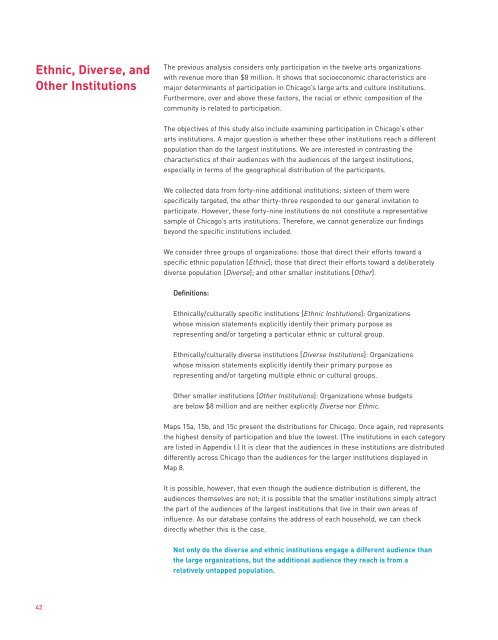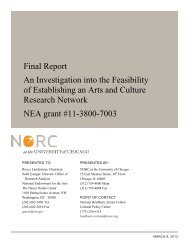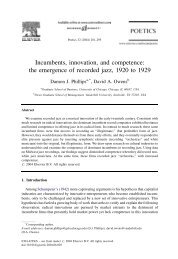Mapping Cultural Participation in Chicago - Cultural Policy Center
Mapping Cultural Participation in Chicago - Cultural Policy Center
Mapping Cultural Participation in Chicago - Cultural Policy Center
Create successful ePaper yourself
Turn your PDF publications into a flip-book with our unique Google optimized e-Paper software.
Ethnic, Diverse, andOther InstitutionsThe previous analysis considers only participation <strong>in</strong> the twelve arts organizationswith revenue more than $8 million. It shows that socioeconomic characteristics aremajor determ<strong>in</strong>ants of participation <strong>in</strong> <strong>Chicago</strong>’s large arts and culture <strong>in</strong>stitutions.Furthermore, over and above these factors, the racial or ethnic composition of thecommunity is related to participation.The objectives of this study also <strong>in</strong>clude exam<strong>in</strong><strong>in</strong>g participation <strong>in</strong> <strong>Chicago</strong>’s otherarts <strong>in</strong>stitutions. A major question is whether these other <strong>in</strong>stitutions reach a differentpopulation than do the largest <strong>in</strong>stitutions. We are <strong>in</strong>terested <strong>in</strong> contrast<strong>in</strong>g thecharacteristics of their audiences with the audiences of the largest <strong>in</strong>stitutions,especially <strong>in</strong> terms of the geographical distribution of the participants.We collected data from forty-n<strong>in</strong>e additional <strong>in</strong>stitutions; sixteen of them werespecifically targeted, the other thirty-three responded to our general <strong>in</strong>vitation toparticipate. However, these forty-n<strong>in</strong>e <strong>in</strong>stitutions do not constitute a representativesample of <strong>Chicago</strong>’s arts <strong>in</strong>stitutions. Therefore, we cannot generalize our f<strong>in</strong>d<strong>in</strong>gsbeyond the specific <strong>in</strong>stitutions <strong>in</strong>cluded.We consider three groups of organizations: those that direct their efforts toward aspecific ethnic population [Ethnic]; those that direct their efforts toward a deliberatelydiverse population [Diverse]; and other smaller <strong>in</strong>stitutions [Other].Def<strong>in</strong>itions:Ethnically/culturally specific <strong>in</strong>stitutions [Ethnic Institutions]: Organizationswhose mission statements explicitly identify their primary purpose asrepresent<strong>in</strong>g and/or target<strong>in</strong>g a particular ethnic or cultural group.Ethnically/culturally diverse <strong>in</strong>stitutions [Diverse Institutions]: Organizationswhose mission statements explicitly identify their primary purpose asrepresent<strong>in</strong>g and/or target<strong>in</strong>g multiple ethnic or cultural groups.Other smaller <strong>in</strong>stitutions [Other Institutions]: Organizations whose budgetsare below $8 million and are neither explicitly Diverse nor Ethnic.Maps 15a, 15b, and 15c present the distributions for <strong>Chicago</strong>. Once aga<strong>in</strong>, red representsthe highest density of participation and blue the lowest. (The <strong>in</strong>stitutions <strong>in</strong> each categoryare listed <strong>in</strong> Appendix I.) It is clear that the audiences <strong>in</strong> these <strong>in</strong>stitutions are distributeddifferently across <strong>Chicago</strong> than the audiences for the larger <strong>in</strong>stitutions displayed <strong>in</strong>Map 8.It is possible, however, that even though the audience distribution is different, theaudiences themselves are not; it is possible that the smaller <strong>in</strong>stitutions simply attractthe part of the audiences of the largest <strong>in</strong>stitutions that live <strong>in</strong> their own areas of<strong>in</strong>fluence. As our database conta<strong>in</strong>s the address of each household, we can checkdirectly whether this is the case.Not only do the diverse and ethnic <strong>in</strong>stitutions engage a different audience thanthe large organizations, but the additional audience they reach is from arelatively untapped population.42









